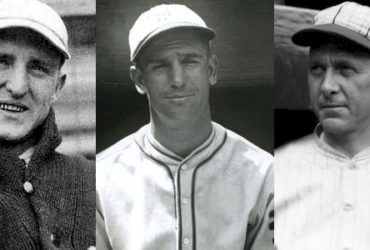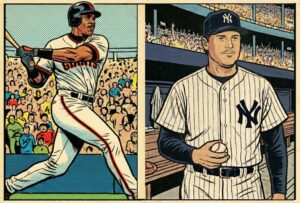First, let me start by stating clearly that I have great respect for the Baseball Hall of Fame. I worked there for seven years, and my children were born in Cooperstown. Love the place. The village is beautiful (except when it’s buried under snow and you have to drive 35-40 miles to get to a decent store), the Museum is amazing, and the atmosphere can’t be matched. It’s a dream come true for a baseball fan.
This article is about the Hall of FAME and the men that are elected to it, and more specifically about the Baseball Writers and the various incarnations of the Veterans Committee who have elected players who were not Hall of Fame caliber. For the most part, the writers have gotten it right, and the Veterans Committee has (a few times) corrected some wrongs. But they’e also made some serious errors. Here are the five players who should never have been elected to the Hall of Fame.
Joe Tinker, Shortstop
Call it the Power of Poetry – that’s what got Joe Tinker into the Hall of Fame. A little poem, a throw-away column written by Franklin Pierce Adams in 1910 for the New York Evening Mail. Adams (a Cubs’ fan) scribbled the poem on his way to the Polo Grounds to watch Chicago play New York. The poem, titled “Baseball’s Sad Lexicon”, reads:
These are the saddest of possible words:
“Tinker to Evers to Chance.”
Trio of bear cubs, and fleeter than birds,
Tinker and Evers and Chance.
Ruthlessly pricking our gonfalon bubble,
Making a Giant hit into a double –
Words that are heavy with nothing but trouble:
“Tinker to Evers to Chance.”
Tinker’s teammates Johnny Evers and Frank Chance were excellent players, worthy of Hall of Fame status, even though neither are all-time greats at their positions. Joe was a mediocre infielder who played on four pennant-winning teams in five years with the Cubs from 1906-1910. His batting stats are poor whether you judge them on peak value of career value: he collected only 1,690 hits and his career slugging was .353, which is bad even for that era. The trio was inducted together in 1946 by the Veterans Committee in a nod much more to the importance of lyrical words than to their greatness as individual players.
Chick Hafey, Left Field
Unlike the others on this list, Hafey was a really good ballplayer most of the time. But he wasn’t in the lineup enough to make him a Hall of Famer. He played in 140 games just twice and in more than 100 games just seven times. His career was over by the age of 32, due to health issues, but he just didn’t do enough for long enough for him to earn his plaque. Hafey was a multi-facted player: hit for average and power and could run, but he was also selfish and he was injured a lot. He owes his HOF status to Frankie Frisch, his teammate on the St. Louis Cardinals for five seasons. When Frisch was an old man he was basically the Dr. Evil of the Hall of Fame Veterans Committee for almost a decade, ruling with an iron hand. He pushed through the election of several of his old cronies. In addition to Hafey, Haines, and Lindstrom on this list, Frisch got George Kelly, Travis Jackson, Ross Youngs, and Jim Bottomley elected either directly or through his influence. It’s the blackest eye on the Hall of Fame voting ledger, and though Hafey was a good player for a short time, he shouldn’t be in the Hall of Fame when there are dozens of players who were better than him who are not.
Jesse Haines, Pitcher
Surely the least talented and accomplished pitcher in the Hall of Fame. Haines had the fortune of playing with Frisch for 11 years and playing under him for five. That association helped grease the wheels for Jesse’s election to the HOF in 1970 by the Vet Committee. This despite the fact that the right-hander pitched 19 years in the National League and led the league in exactly three categories: games pitched in 1920, and complete games and shutouts in 1927. In all those years he received MVP votes in only one season, and even then he was 8th in balloting. Haines was never one of the marguee pichers in the game, or even on his own team much of his career. The Cardinals went to the World Series three times with Haines as a part of their rotation, and he never once started Game One of the Fall Classic, in fact he was usually the third pitcher in their rotation. Haines did pitch well in the post-season, but he was not a great pitcher. He pitched for a very long time and was part of four pennant-winning clubs, but he won more than 13 games only four times in his 19 seasons. His 3.64 ERA is the highest of any starting pitcher in Cooperstown.
Herb Pennock, Pitcher
For more than a decade, Pennock was a mediocre pitcher (77-72, 3.72 ERA in mostly the Deadball Era). Then when he was 29 years old he was dealt to the Yankees and he started to win games, which isn’t hard to understand considering Babe Ruth and Lou Gehrig were his teammates. Pennock didn’t even really win that much for a Yankee pitcher in the 1920s and 1930s – he averaged 14 victories per season with the Bombers. His ERA was good in only five of his seasons with New York, otherwise it was higher than league average. He was 5-0 in World Series games, so he has that going for him. But the lefty had a career 3.60 ERA (about 5% better than league average), gave up a ton of hits, and didn’t strike out many batters at all (three per nine innings – an abysmal mark even for that era). He was a slightly better than average pitcher who had the fortune of being on great Yankee teams. He was nowhere near as good a pitcher as say, David Cone or David Wells or Kevin Brown or Andy Pettitte. Or to take a few from his era: Wes Ferrell, Tommy Bridges, Charlie Root, or Ray Kremer. And none of those gentlemen are in the Hall of Fame.
Freddie Lindstrom, Third Base
As bad as all these selections were, Lindstrom is the absolute worst, and the blame goes to the Veterans Committee, who selected him in 1976. Lindstrom was on the writers’ ballot five times and never received more than seven votes! The BBWAA obviously never thought Lindstrom was Hall-worthy, and there was never a campaign to get him in by anyone in the ensuing years, until Frisch was appointed to the Vet Committee and bandied about Freddie’s name a lot. Even though Frisch was dead by 1976, his handy work was done and the Committee saw Lindstrom’s .311 batting average as a third baseman and fell in love. The fact is, Lindstrom had a couple of fine years but he only played regularly in about nine seasons, and his .316 average isn’t that wonderful when you realize he accumulated it during the best hitting era in baseball, when a .300 average was, well… average for several seasons. How good was he with the glove? Well, consider that the year after he hit .379 with 231 hits, the Giants moved him from third base to right field. He was a miserable fielder, an above-average hitter, and he only really had a handful of seasons where he played at a high level. The rest of the time he was average.







